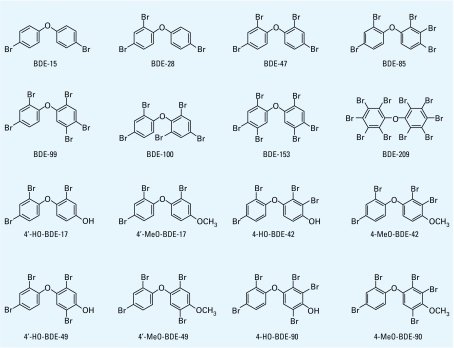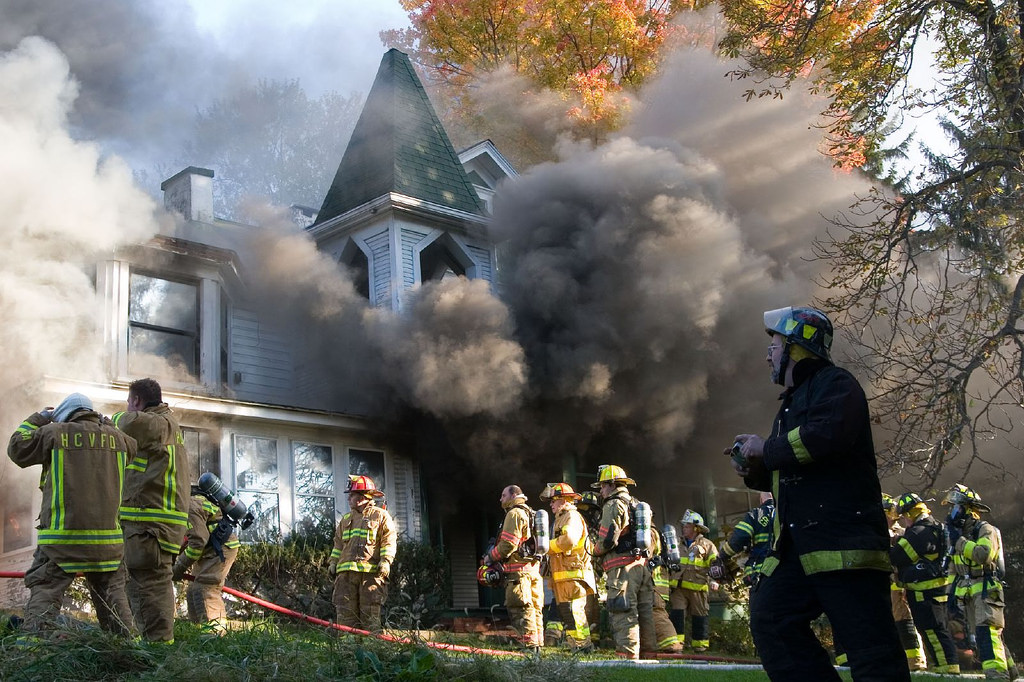
Flame Retardants
|
Don't flame retardants keep us safe? A 2011 article reviewed evidence of both risks and benefits of flame retardants in furniture foam. The researchers' conclusions:
See the Regulation section of this webpage below for more information about TB117. |
Flame retardants, advertised to decrease the ability of materials to ignite and cause harm to humans, have been added to a range of products since the 1960s. Though many flame retardants are no longer produced, they do not easily break down, remaining in the environment for years and bioaccumulating in people and animals over time.2 Humans are exposed to flame retardant chemicals daily. Studies have shown that some may be hazardous to people and animals.3
Types of Flame Retardants
There are hundreds of different flame retardants, categorized based on chemical structure and properties. Two commonly used flame retardants are brominated flame retardants and organophosphorus flame retardants.4
Brominated Flame Retardants
These are the most abundantly used flame retardants, added to electronics, furniture, building materials and automobiles. These chemicals do not dissolve easily in water; they adhere to particles and build up in river beds and lake sediment.5 They have been found in humans and animals.6
Polybrominated diphenyl ethers (PBDE’s), a subset of brominated flame retardants that replaced polybrominated biphenyls, are man-made industrial chemicals added to consumer products to meet flammability standards set in the 1970s. Some PBDEs can build up in certain fish and mammals when they eat contaminated food or water.7
The various chemicals within the family of 209 PBDEs are named for the number of bromine atoms attached to the central molecule—hence the term "polybrominated" in the name. PBDEs discussed here:
| Chemical Name | Uses |
| TetraBDE (4 bromine atoms) | May be present in some pentaBDE formulations8 |
| PentaBDE (5 bromine atoms) | 90-95% of this chemical is used in polyurethane mattresses and foam cushioning in upholstery, with minor use in textiles, paints, lacquers and hydraulic oils.9 |
| OctaBDE (8 bromine atoms) | Business equipment, automobile trim, telephones and kitchen appliance casings10 |
| DecaBDE (10 bromine atoms) | Electronic enclosures, such as wire insulation, televisions and computers;11 also used in furniture cushions, upholstery textiles, carpet backings, mattresses, vehicles, aircraft and building materials12 |
|
PBDE chemical structures, from Open-i; click to see the image on that site |
The PBDEs decaBDE (BDE-209), tetraBDE (BDE-47) and pentaBDE (BDE-99) are of health interest. In general, lower brominated compounds are more toxic than higher brominated compounds.
PBDEs do not chemically bind to the products they have been added to and easily travel (migrate or leach) from these products into air and dust. The release of PBDEs from products typically increases with use and age. PBDEs are also released in the manufacturing process and during product disposal.
Although many PBDEs have been banned or phased out of production, they remain in the environment due to their extensive use and chemical persistence. DecaBDE is known to break down into the more toxic pentaBDE and tetraBDE, making its use an ongoing concern, although the rate of deca-DBE degradation in the environment is unknown.13
![]() Tetrabromobisphenol A (TBBPA) is used widely in electronics, circuit boards, some textiles and paper. It is globally the most highly produced brominated flame retardant, with human exposure to it widespread. It has been found in human tissue and household dust, as well as other places in the environment, including soil, water and fish.
Tetrabromobisphenol A (TBBPA) is used widely in electronics, circuit boards, some textiles and paper. It is globally the most highly produced brominated flame retardant, with human exposure to it widespread. It has been found in human tissue and household dust, as well as other places in the environment, including soil, water and fish.
Hexabromocyclododecane (HBCD) is an additive used in polystyrene foam building materials from which it can leach and attach to indoor dust. Lower levels have been discovered in some food products.14
Organophosphate Flame Retardants (OPFRs)
![]() With the phase out of some PBDEs, some OPFRs have been used as replacements. The National Toxicology Program is assessing these replacements for potential hazards, using in vitro and alternative animal models. Some of the replacement OPFRs have activity comparable to the phased-out PBDEs and structural similarities with organophosphorus insecticides, which are known to be neurotoxic.
With the phase out of some PBDEs, some OPFRs have been used as replacements. The National Toxicology Program is assessing these replacements for potential hazards, using in vitro and alternative animal models. Some of the replacement OPFRs have activity comparable to the phased-out PBDEs and structural similarities with organophosphorus insecticides, which are known to be neurotoxic.
Other Flame Retardants
|
TDCPP chemical structure |
The chlorinated organophosphate tris(1,3-dichloro-2-propyl)phosphate (TDCPP, or Tris) is added to polyurethane foam used in upholstered furniture. It was banned in 1970s from use in children’s pajamas due to its mutagenic properties, but is still found in households with foam, including baby products. Because of the 2006 ban on pentaBDE, the use of TDCPP has been increasing. In 2011, California added TDCPP to its Proposition 65 list of suspected carcinogens.
Firemaster® 550 is a mixture of brominated and non-halogen flame retardants used as an alternative to pentaBDE. From studies by the manufacturer, Chemtura Corporation, the US EPA concluded that TBB—the primary component of Firemaster® 550—is less persistent and less likely to bioaccumulate than pentaBDE. It was found to be suitable for use as a flame retardant in highly flammable foam.15 An independent study published in 2013 has since raised serious questions about its health impacts.16
Health Effects
|
Exposure |
Associated Health Impacts |
|---|---|
|
Flame retardants generally |
Reproductive toxicity, cancer, impaired neurological development, endocrine disruption, immune disruption17 |
|
PBDEs |
Lower birth weight and length,18 impaired neurological development in children,19 plus cancer20 and behavior changes21 in animal studies; although the EPA sites inadequate data to assess carcinogenic potential of the penta- and tetra- formulations, decaBDE is listed as having ‘suggestive evidence of carcinogenic potential’ from studies exposing rats to extremely large quantities of pentaBDE22 |
|
TBBPA |
|
|
HBCD |
Some indications of neurologic effects, but not conclusive25 |
|
TDCPP |
Cancer in animals,26 endocrine disruption27 |
|
Firemaster 550 |
In rats, endocrine and metabolic effects, risk for obesity and early onset puberty28 |
Vulnerable populations
|
image from Oleg Sldorenko at Creative Commons |
Children. As flame retardants can affect the developing nervous system, children are particularly vulnerable. Their hand-to-mouth behaviors, increased breathing rates and proximity to materials containing flame retardants increases their risk for exposure. Investigations have found that children have a higher concentration of flame retardants circulating in their bodies than adults,29 and flame retardants have been found in toddler excrement. A 25-year Swedish study found that the concentration of PBDEs in breast milk doubled every five years during the 25-year period.30
|
image from Snarkle Motion at Creative Commons |
Workers at sites handling products containing flame retardants are at a higher risk of exposure from burning, recycling or dismantling these products, increasing the risk that chemicals will be absorbed by the body.31
Firefighters are also at an increased risk of exposure. TDCPP, the chemical removed from children’s pajamas decades ago, is now found in fire stations at levels of concern. Researchers suspect fire fighters are carrying it back on clothing and equipment after being exposed on the fire ground. The Chicago Tribune highlighted the relationship between flame retardants and increased incidence of cancer in firefighters in their series, “Playing with Fire.”
Routes of Exposure
|
image from Chris Dixon at Creative Commons |
Chemicals can leach from products into dust and into the air, and then dust can transfer to hands and food where it is later ingested. Flame retardants can also enter the environment through burning or dismantling e-waste. Burning of flame retardants during house fires is a special concern to firefighters who are often exposed to heavy amounts of smoke containing these chemicals.32 During manufacturing, these chemicals can enter surrounding air, water and soil. Chemicals in air and water can travel great distances on air and water currents and are now found worldwide. Levels of some retardants in the Arctic are extremely concerning.33
|
image from Mike Liu at Creative Commons |
People are exposed primarily through diet and inhalation of off-gassing from products in the home and in cars, airplanes and workplaces. House dust is a significant source of exposure.34 PBDEs are found increasingly in food, including breast milk,35 and especially oils and fats, fish and shellfish, meat and meat products.36 PBDEs have been found in butter at alarming levels, leached from contaminated wrapping materials.37
Reducing Exposures
![]() The National Institute of Environmental Health Sciences and Toxipedia recommend these ways to reduce your exposure to flame retardants:38
The National Institute of Environmental Health Sciences and Toxipedia recommend these ways to reduce your exposure to flame retardants:38
-
Keep dust levels down by dusting with a damp rag, wet mopping and vacuuming with a high-efficiency particulate air (HEPA) filter to help remove contaminants from your home.
image from Sarah & co at Creative Commons
- Wash your hands and those of your children often. Hand-to-mouth contact exposes people to flame retardants.
- When purchasing new products, try to purchase baby products and furniture filled with cotton, polyester, or wool, instead of polyurethane foam.
- Reduce dust by having a good ventilation system in your home.
- Cover and seal rips in upholstery that expose polyurethane foam, especially if the foam is loose and crumbling.
- Contact your mattress manufacturer to see whether your mattress is made with polyurethane foam that contains PBDEs. If it does, but you aren't ready to replace your mattress, consider purchasing a tightly woven allergen-barrier mattress casing to reduce the migration of PBDEs into dust.
Regulation
![]() EPA has set reference doses for oral chronic ingestion of deca-, penta- and tetraBDEs, assessing a neurological chronic health hazard endpoint. The Federal Food and Drug Administration (FDA), the US Department of Agriculture (USDA), the Consumer Protection Safety Commission (CPSC) and the Occupational Safety and Health Administration (OSHA) have not provided clear exposure guidance or regulation. The CPSC has indicated that TDCPP may pose a threat to human health.
EPA has set reference doses for oral chronic ingestion of deca-, penta- and tetraBDEs, assessing a neurological chronic health hazard endpoint. The Federal Food and Drug Administration (FDA), the US Department of Agriculture (USDA), the Consumer Protection Safety Commission (CPSC) and the Occupational Safety and Health Administration (OSHA) have not provided clear exposure guidance or regulation. The CPSC has indicated that TDCPP may pose a threat to human health.
The Centers for Disease Control (CDC) is not a regulatory body but its Agency for Toxic Substances and Disease Registry (ATSDR) is directed by Congressional mandate to perform specific functions concerning the effect on public health of hazardous substances in the environment.39 ATSDR has released recommended exposure limits for acute and intermediate and exposure to PBDEs in general and intermediate exposure to decaBDE specifically. ATSDR stated a chronic exposure level could not be set citing incomplete data.40
Other non-regulatory entities have made recommendations regarding PBDE exposure based on scientific data regarding human health endpoints. Though OSHA has not released a recommendation for exposure to decaBDE, the American Industrial Hygiene Association (AIHA) has made a recommended for workplace environmental exposure levels.41
Pressure has influenced some manufacturers into voluntarily phasing out PBDEs. Leaders in industry include IKEA, Apple, Dell, Canon, HP, Mitsubishi, Panasonic, Samsung, Sony, Sealy, Select Comfort, Serta, Simmons, Tempur-Pedic and Xerox. These companies have redesigned their products to incorporate phosphorous-based flame retardants, flame resistant plastics without PBDEs, halogen-free low-voltage internal wiring, fire barriers and bromine-free circuit boards.42
Manufacturing of pentaBDEs was voluntarily phased out beginning in 2004 due to health concerns. All PBDEs were voluntarily banned in the EU, and octaBDEs and pentaBDEs have been banned nationwide in the US, with certain states also banning decaBDEs.43 In December 2009, the largest commercial producers and suppliers of decaBDE in the United States agreed to phase out use of the chemical by the end of 2013.44 Safer States maintains a Bill Tracker for Toxic Flame Retardants providing information on the status of legislative action on all types of flame retardants.
In 2008, the US Consumer Product Safety Commission proposed a smolder test for fabric called 16 CFR Part 1634. Similar to TB-117-2013 (see box at right), this test would not lead to the use of flame retardant chemicals. There is no timeline for implementation of this proposed standard.48
See more about flame retardants and health in the list of CHE publications and Dig Deeper resources in the right sidebar.
This page's content was created by Lorelei Walker, PhD, and Nancy Hepp and last revised in August 2016. Content from Toxipedia is noted with the logo.
CHE invites our partners to submit corrections and clarifications to this page. Please include links to research to support your submissions through the comment form on our Contact page.
*header image from State Farm at Creative Commons








